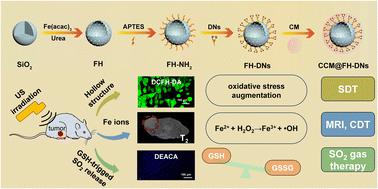当前位置:
X-MOL 学术
›
Biomater. Sci.
›
论文详情
Our official English website, www.x-mol.net, welcomes your feedback! (Note: you will need to create a separate account there.)
Glutathione-triggered release of SO2 gas to augment oxidative stress for enhanced chemodynamic and sonodynamic therapy
Biomaterials Science ( IF 6.6 ) Pub Date : 2024-03-05 , DOI: 10.1039/d3bm02027d Ya Tian 1 , Pei Li 2 , Likai Wang 1 , Xueli Ye 1 , Zhonghuan Qu 1 , Juan Mou 1 , Shiping Yang 1 , Huixia Wu 1
Biomaterials Science ( IF 6.6 ) Pub Date : 2024-03-05 , DOI: 10.1039/d3bm02027d Ya Tian 1 , Pei Li 2 , Likai Wang 1 , Xueli Ye 1 , Zhonghuan Qu 1 , Juan Mou 1 , Shiping Yang 1 , Huixia Wu 1
Affiliation

|
Recently, gas therapy has emerged as a promising alternative treatment for deep-seated tumors. However, some challenges regarding insufficient or uncontrolled gas generation as well as unclear therapeutic mechanisms restrict its further clinical application. Herein, a well-designed nanoreactor based on intracellular glutathione (GSH)-triggered generation of sulfur dioxide (SO2) gas to augment oxidative stress has been developed for synergistic chemodynamic therapy (CDT)/sonodynamic therapy (SDT)/SO2 gas therapy. The nanoreactor (designed as CCM@FH-DNs) is constructed by employing iron-doped hollow mesoporous silica nanoparticles as carriers, the surface of which was modified with the SO2 prodrug 2,4-dinitrobenzenesulfonyl (DNs) and further coated with cancer cell membranes for homologous targeting. The CCM@FH-DNs can not only serve as a Fenton-like agent for CDT, but also as a sonosensitizer for SDT. Importantly, CCM@FH-DNs can release SO2 for SO2-mediated gas therapy. Both in vitro and in vivo evaluations demonstrate that the CCM@FH-DNs nanoreactor performs well in augmenting oxidative stress for SO2 gas therapy-enhanced CDT/SDT via GSH depletion and glutathione peroxidase-4 enzyme deactivation as well as superoxide dismutase inhibition. Moreover, the doped iron ions ensure that the CCM@FH-DNs nanoreactors enable magnetic resonance imaging-guided therapy. Such a GSH-triggered SO2 gas therapy-enhanced CDT/SDT strategy provides an intelligent paradigm for developing efficient tumor microenvironment-responsive treatments.
中文翻译:

谷胱甘肽触发释放 SO2 气体以增强氧化应激,从而增强化学动力学和声动力学治疗
最近,气体疗法已成为治疗深部肿瘤的一种有前景的替代疗法。然而,气体产生不足或不受控制以及治疗机制不清楚等一些挑战限制了其进一步的临床应用。在此,我们开发了一种基于细胞内谷胱甘肽(GSH)触发产生二氧化硫(SO 2)气体以增强氧化应激的精心设计的纳米反应器,用于协同化学动力学疗法(CDT)/声动力学疗法(SDT)/SO 2气体疗法。该纳米反应器(设计为CCM@FH-DNs)是以铁掺杂中空介孔二氧化硅纳米粒子为载体,表面用SO 2前药2,4-二硝基苯磺酰基(DNs)修饰,并进一步包被癌细胞而构建的。用于同源靶向的膜。CCM@FH-DNs不仅可以作为CDT的类芬顿剂,还可以作为SDT的声敏剂。重要的是,CCM@FH-DNs可以释放SO 2用于SO 2介导的气体疗法。体外和体内评估均表明,CCM@FH-DNs 纳米反应器通过GSH 消耗、谷胱甘肽过氧化物酶 4 酶失活以及超氧化物歧化酶抑制,在增强 SO 2气体疗法增强 CDT/SDT 的氧化应激方面表现良好。此外,掺杂的铁离子确保CCM@FH-DNs纳米反应器能够实现磁共振成像引导治疗。这种GSH触发的SO 2气体治疗增强的CDT/SDT策略为开发有效的肿瘤微环境响应治疗提供了智能范例。
更新日期:2024-03-05
中文翻译:

谷胱甘肽触发释放 SO2 气体以增强氧化应激,从而增强化学动力学和声动力学治疗
最近,气体疗法已成为治疗深部肿瘤的一种有前景的替代疗法。然而,气体产生不足或不受控制以及治疗机制不清楚等一些挑战限制了其进一步的临床应用。在此,我们开发了一种基于细胞内谷胱甘肽(GSH)触发产生二氧化硫(SO 2)气体以增强氧化应激的精心设计的纳米反应器,用于协同化学动力学疗法(CDT)/声动力学疗法(SDT)/SO 2气体疗法。该纳米反应器(设计为CCM@FH-DNs)是以铁掺杂中空介孔二氧化硅纳米粒子为载体,表面用SO 2前药2,4-二硝基苯磺酰基(DNs)修饰,并进一步包被癌细胞而构建的。用于同源靶向的膜。CCM@FH-DNs不仅可以作为CDT的类芬顿剂,还可以作为SDT的声敏剂。重要的是,CCM@FH-DNs可以释放SO 2用于SO 2介导的气体疗法。体外和体内评估均表明,CCM@FH-DNs 纳米反应器通过GSH 消耗、谷胱甘肽过氧化物酶 4 酶失活以及超氧化物歧化酶抑制,在增强 SO 2气体疗法增强 CDT/SDT 的氧化应激方面表现良好。此外,掺杂的铁离子确保CCM@FH-DNs纳米反应器能够实现磁共振成像引导治疗。这种GSH触发的SO 2气体治疗增强的CDT/SDT策略为开发有效的肿瘤微环境响应治疗提供了智能范例。



























 京公网安备 11010802027423号
京公网安备 11010802027423号